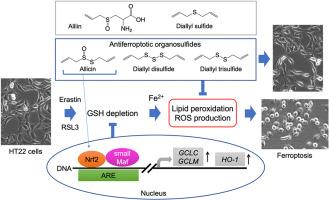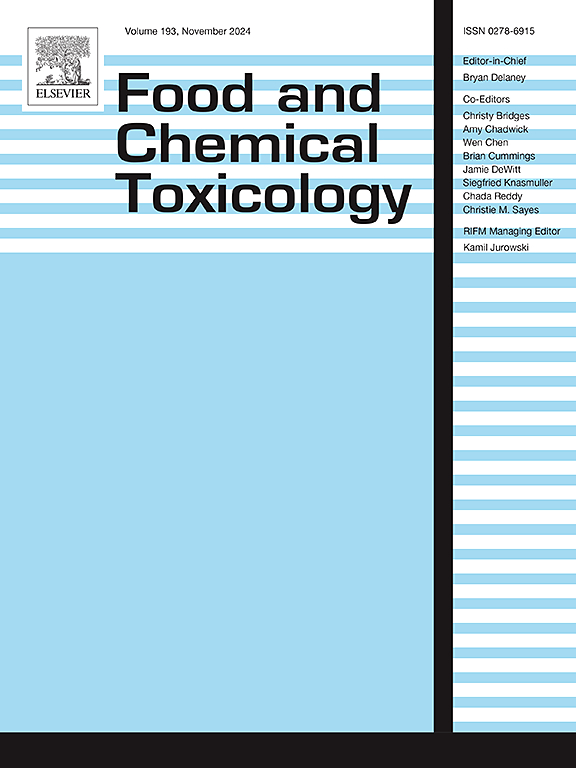来自大蒜的 alicin 和相关有机硫化合物-二烯丙基二硫化物和二烯丙基三硫化物的抗荧光素特性。
IF 3.9
3区 医学
Q2 FOOD SCIENCE & TECHNOLOGY
引用次数: 0
摘要
大蒜素(硫代硫酸二烯丙酯)是大蒜(Allium sativum L.)中一种丰富的生物活性化合物,具有广谱抗炎、抗真菌、抗氧化和抗肿瘤特性。包括大蒜素在内的大蒜生物活性化合物也可能有助于降低各种疾病的发病率,尽管其各自的贡献和确切的机制在很大程度上仍然未知。在这项研究中,我们发现大蒜素和与之密切相关的二烯丙基二硫化物和二烯丙基三硫化物(均含有一个以上的二硫键)可保护小鼠海马 HT22 细胞免受化学诱导的铁中毒,铁中毒是一种新定义的细胞死亡形式,其特征是铁依赖性脂质过氧化。相比之下,这些有机硫化合物并不能防止化学诱导的细胞凋亡。这些化合物的抗铁锈色素沉着功效与防止脂质过氧化和活性氧生成密切相关,但与谷胱甘肽上调、亚铁螯合以及核因子红细胞 2(NF-E2)相关因子-2-抗氧化元素反应途径的调节无关。关于大蒜素和大蒜中的相关化合物对与铁氧化相关的神经退行性疾病的治疗潜力,还需要进行更多的研究。本文章由计算机程序翻译,如有差异,请以英文原文为准。

Antiferroptotic properties of allicin and related organosulfur compounds—diallyl disulfide and diallyl trisulfide—from Garlic
Allicin (diallyl thiosulfinate) is an abundant bioactive compound in garlic (Allium sativum L.) with broad-spectrum antiinflammatory, antifungal, antioxidant, and antitumor properties. The bioactive compounds of garlic including allicin may also help reduce the incidence of various diseases, although the individual contributions and precise mechanisms are still largely unknown. In this study, we reveal that allicin and the closely related compounds diallyl disulfide and diallyl trisulfide (all containing more than one disulfide bond) protect mouse hippocampal HT22 cells against chemically induced ferroptosis, a newly defined form of cell death characterized by iron-dependent lipid peroxidation. In contrast, these organosulfur compounds did not prevent chemically induced apoptosis. The antiferroptotic efficacies of these compounds were strongly associated with prevention of lipid peroxidation and reactive oxygen species production but independent of glutathione upregulation, ferrous iron chelation, and modulation of the nuclear factor erythroid 2 (NF-E2)-related factor-2-antioxidant element response pathway. Additional studies are warranted on the therapeutic potential of allicin and related compounds in garlic for neurodegenerative diseases associated with ferroptosis.
求助全文
通过发布文献求助,成功后即可免费获取论文全文。
去求助
来源期刊

Food and Chemical Toxicology
工程技术-毒理学
CiteScore
10.90
自引率
4.70%
发文量
651
审稿时长
31 days
期刊介绍:
Food and Chemical Toxicology (FCT), an internationally renowned journal, that publishes original research articles and reviews on toxic effects, in animals and humans, of natural or synthetic chemicals occurring in the human environment with particular emphasis on food, drugs, and chemicals, including agricultural and industrial safety, and consumer product safety. Areas such as safety evaluation of novel foods and ingredients, biotechnologically-derived products, and nanomaterials are included in the scope of the journal. FCT also encourages submission of papers on inter-relationships between nutrition and toxicology and on in vitro techniques, particularly those fostering the 3 Rs.
The principal aim of the journal is to publish high impact, scholarly work and to serve as a multidisciplinary forum for research in toxicology. Papers submitted will be judged on the basis of scientific originality and contribution to the field, quality and subject matter. Studies should address at least one of the following:
-Adverse physiological/biochemical, or pathological changes induced by specific defined substances
-New techniques for assessing potential toxicity, including molecular biology
-Mechanisms underlying toxic phenomena
-Toxicological examinations of specific chemicals or consumer products, both those showing adverse effects and those demonstrating safety, that meet current standards of scientific acceptability.
Authors must clearly and briefly identify what novel toxic effect (s) or toxic mechanism (s) of the chemical are being reported and what their significance is in the abstract. Furthermore, sufficient doses should be included in order to provide information on NOAEL/LOAEL values.
 求助内容:
求助内容: 应助结果提醒方式:
应助结果提醒方式:


